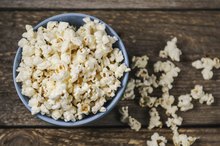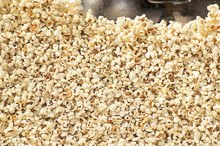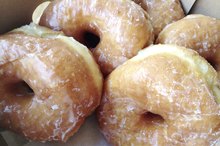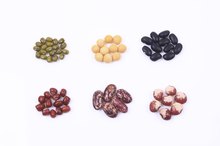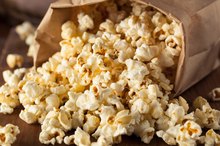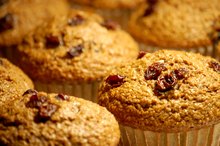Popcorn on a Low-Carb Diet
Following a low-carb diet requires you to drastically reduce your intake of carbohydrate-rich foods, such as fruits, vegetables and grains. On a regular 2,000-calorie diet, you should consume between 225 and 325 g of carbs. Low-carb diets reduce your carbohydrates to 50 to 150 g. Popcorn does contain carbs, but cutting down your portion size can allow you to continue to enjoy this popular snack.
The Popcorn Kernel
Popcorn is a whole grain food made from a particular type of corn kernels. While there are several varieties of corn, only one type, zea mays everta, actually can pop, explains The Popcorn Board. Kernels are composed of three parts: the germ, endosperm and pericarp, or hull. The endosperm is rich in carbohydrates and provides energy to the germ for growth. These parts are protected by the outer pericarp, which is rich in cellulose, a type of fiber.
- Popcorn is a whole grain food made from a particular type of corn kernels.
- These parts are protected by the outer pericarp, which is rich in cellulose, a type of fiber.
Grams of Carbohydrates
What Starch Is in Popcorn?
Learn More
Popcorn is a rich source of carbohydrates, but it does provide a small amount of protein as well. MyPyramid.com suggests consuming 3 to 4 oz. or equivalent of grain foods each day. While following a low-carb diet, you might want to cut those servings in half. Since popcorn is so light and airy, a 1 oz. equivalent of popcorn is 3 cups. This serving size has less than 20 g of carbs and about 3 g of protein.
- Popcorn is a rich source of carbohydrates, but it does provide a small amount of protein as well.
- MyPyramid.com suggests consuming 3 to 4 oz.
Types of Carbs
Low-carb diets tend to restrict high-fiber foods from your diet. Most of the carbohydrates in popcorn, about 75 percent, is starch. This type of carb breaks down quickly, giving you energy immediately. The remaining 25 percent of carbohydrates comes from fiber. Popcorn is a good source of insoluble fiber, which stays relatively intact in your gut and helps push through digested food, promoting regularity. In addition, insoluble fiber from popcorn takes longer to chew, allowing your body to register that it is full early on. This can help your weight-loss efforts, since you'll be less likely to overeat. Enjoying a serving of high-fiber popcorn in the afternoon can keep you satisfied until dinner.
- Low-carb diets tend to restrict high-fiber foods from your diet.
- In addition, insoluble fiber from popcorn takes longer to chew, allowing your body to register that it is full early on.
Additional Considerations
Harkins Popcorn Nutrition
Learn More
Air-popped popcorn is naturally low in fat and calories. Adding butter, oil or other toppings increases your intake of nutrients. Tossing popcorn in these fats does not increase the carbohydrate content, but it can double the amount of calories. A 3 cup serving of air-popped corn has about 1 g of fat, but adding butter or oil can pack on an additional 10 g or more. Keep your low-carb diet on track by snacking on plain air-popped popcorn. For flavor, sprinkle your snack with hot sauce, garlic powder or cinnamon. They add flavor without adding carbs, fat or calories.
- Air-popped popcorn is naturally low in fat and calories.
- A 3 cup serving of air-popped corn has about 1 g of fat, but adding butter or oil can pack on an additional 10 g or more.
Related Articles
References
- The Popcorn Board: What is Popcorn?
- Marks Daily Apple: The Primal Blueprint Carbohydrate Curve
- Nguyen, V., Cooper, L., Lowndes, J. et al. Popcorn is more satiating than potato chips in normal-weight adults. Nutr J 11, 71 (2012). doi:10.1186/1475-2891-11-71
- Coco MG, Vinson JA. Analysis of popcorn (Zea mays L. var. everta) for antioxidant capacity and total phenolic content. Antioxidants (Basel). 2019;8(1). doi:10.3390/antiox8010022
- Zhou Y, Zheng J, Li Y, et al. Natural polyphenols for prevention and treatment of cancer. Nutrients. 2016;8(8) doi:10.3390/nu8080515
- Cleveland Clinic. Diverticular disease: greatest myths and facts. 2020.
- American Cancer Society. Teflon and perfluorooctanoic acid (PFOA). Updated January 5, 2016.
- Begley TH, White K, Honigfort P, Twaroski ML, Neches R, Walker RA. Perfluorochemicals: potential sources of and migration from food packaging. Food Addit Contam. 2005;22(10):1023-31. doi:10.1080/02652030500183474
- American College of Allergy, Asthma & Immunology. Corn allergy. Updated March 8, 2019.
- American Chemical Society (ACS). Popcorn: The snack with even higher antioxidants levels than fruits and vegetables. ACS Meeting; San Diego, California; March 25, 2012.
Writer Bio
Melodie Anne Coffman specializes in overall wellness, with particular interests in women's health and personal defense. She holds a master's degree in food science and human nutrition and is a certified instructor through the NRA. Coffman is pursuing her personal trainer certification in 2015.
